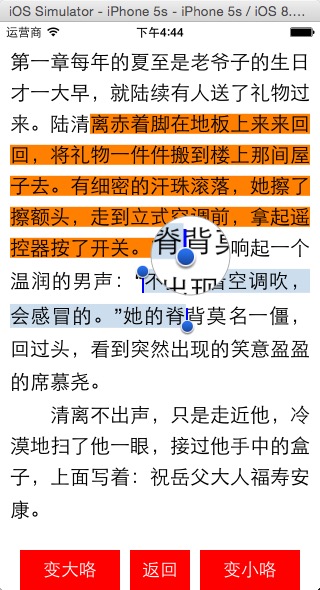手把手教你Masonry的理解
我們先來看看是如何開始使用Masonry的,一般我們使用這個布局框架的時候,都會調用以下代碼。。。。。
[self.view1 mas_makeConstraints:^(MASConstraintMaker *make) {
make.left.mas_equalTo(50);
make.right.mas_equalTo(-50);
make.top.mas_equalTo(50);
make.bottom.mas_equalTo(-50);
}];我們來分析下這段代碼,UIView類型的使用了mas_makeConstraints這個方法,這個是寫在分類裡面的,有一個block參數,我們看一下裡面的實現代碼:
- (NSArray *)mas_makeConstraints:(void(^)(MASConstraintMaker *))block {
self.translatesAutoresizingMaskIntoConstraints = NO;
MASConstraintMaker *constraintMaker = [[MASConstraintMaker alloc] initWithView:self];
block(constraintMaker); return [constraintMaker install];
}首先設置translatesAutoresizingMaskIntoConstraints屬性為NO
第二行初始化了一個MASConstraintMaker類,那這個類裡面做了什麼操作呢,好吧,本著刨根問底的精神我們繼續往下看
- (id)initWithView:(MAS_VIEW *)view {
self = [super init]; if (!self) return nil;
self.view = view;
self.constraints = NSMutableArray.new;
return self;
}將當前的view賦給maker類,然後初始化constraints,這是一個約束數組。
我們仔細看block(constraintMaker);這一行代碼。。。
神馬意思呢?
首先這個block是(void(^)(MASConstraintMaker *))類型的一個參數,我們其實可以更改為其它名稱,感覺用block就有點混淆。。。
- (NSArray *)mas_makeConstraints:(void(^)(MASConstraintMaker *))constraintMakerblock {
self.translatesAutoresizingMaskIntoConstraints = NO;
MASConstraintMaker *constraintMaker = [[MASConstraintMaker alloc] initWithView:self];
constraintMakerblock(constraintMaker); return [constraintMaker install];
}比如可以更改為上面的形式...
這段代碼的理解就是初始化了一個constraintMaker類,然後設置它的constraint屬性,最後加載安裝(install)
[self.view1 mas_makeConstraints:^(MASConstraintMaker *make) {
make.left.mas_equalTo(50);
make.right.mas_equalTo(-50);
make.top.mas_equalTo(50);
make.bottom.mas_equalTo(-50);
}];注意:這種寫法很容易理解為這是一個block,但其實只是在執行一個函數,後面一大塊只不過是函數的一個參數而已,只不過它的參數是一個函數。
它等價與下面的一種寫法:
self.view1.translatesAutoresizingMaskIntoConstraints = NO; MASConstraintMaker *constraintMaker = [[MASConstraintMaker alloc] initWithView:self.view1]; constraintMaker.left.mas_equalTo(50); constraintMaker.right.mas_equalTo(-50); constraintMaker.top.mas_equalTo(50); constraintMaker.bottom.mas_equalTo(-50); [constraintMaker install];
那這樣寫的話就不是很方便了,那麼有什麼辦法嗎???
我們把它封裝成一個函數???好的,封裝成一個函數我們要做幾件事情
-(void)addMakeConstraints
{
//初始化MASConstraintMaker
self.translatesAutoresizingMaskIntoConstraints = NO;
MASConstraintMaker *constraintMaker = [[MASConstraintMaker alloc] initWithView:self];
//設置它的屬性
// .........
//加載
[constraintMaker install];
}那麼第二步該怎麼做呢?
傳參數???但是參數有很多呀??怎麼辦??
比如我設置一個字典,裡面用key,value來表示(left:50,right:-50,top:50,bottom:-50)好像也可以,但總覺的不是很方便
-(void)addMakeConstraints:(NSMutableDictionary *)dictionary
{
//初始化MASConstraintMaker
self.translatesAutoresizingMaskIntoConstraints = NO;
MASConstraintMaker *constraintMaker = [[MASConstraintMaker alloc] initWithView:self];
//設置它的屬性
// .........
constraintMaker.left.mas_equalTo([dictionary[@"left"] intValue]);
constraintMaker.right.mas_equalTo([dictionary[@"right"] intValue]);
constraintMaker.top.mas_equalTo([dictionary[@"top"] intValue]);
constraintMaker.bottom.mas_equalTo([dictionary[@"bottom"] intValue]);
//加載
[constraintMaker install];
}NSMutableDictionary *constraint=[[NSMutableDictionary alloc]init]; [constraint setObject:@"50" forKey:@"left"]; [constraint setObject:@"-50" forKey:@"right"]; [constraint setObject:@"50" forKey:@"top"]; [constraint setObject:@"-50" forKey:@"bottom"]; [self.view1 addMakeConstraints:constraint];
貌似也可以實現的額,那有沒有什麼更好地辦法呢?我們看下第一種寫法:
-(void)addMakeConstraints
{
//初始化MASConstraintMaker
self.translatesAutoresizingMaskIntoConstraints = NO;
MASConstraintMaker *constraintMaker = [[MASConstraintMaker alloc] initWithView:self];
//設置它的屬性
// .........
//加載
[constraintMaker install];
}其實我們中間就是缺了一段代碼:那可以使用delegate嗎
-(void)addMakeConstraints
{
//初始化MASConstraintMaker
self.translatesAutoresizingMaskIntoConstraints = NO;
MASConstraintMaker *constraintMaker = [[MASConstraintMaker alloc] initWithView:self];
[self.del addConstraint:constraintMaker];
//加載
[constraintMaker install];
}-(void)addConstraint:(MASConstraintMaker *)maker
{
maker.left.mas_equalTo(50);
maker.right.mas_equalTo(-50);
maker.top.mas_equalTo(50);
maker.bottom.mas_equalTo(-50);
}既然可以用代理實現,那麼block肯定也是可以的
好的,我們改裝成block版本
-(void)addMakeConstraints
{
//初始化MASConstraintMaker
self.translatesAutoresizingMaskIntoConstraints = NO;
MASConstraintMaker *constraintMaker = [[MASConstraintMaker alloc] initWithView:self];
self.makerBlock(constraintMaker);
//加載
[constraintMaker install];
}[self.view1 addMakeConstraints];
self.view1.makerBlock=^(MASConstraintMaker *maker){
maker.left.mas_equalTo(50);
maker.right.mas_equalTo(-50);
maker.top.mas_equalTo(50);
maker.bottom.mas_equalTo(-50);
};在這裡,我們是作為一個屬性來使用block的,那麼我們還可以直接用參數作為block來實現的。
也就是說把這段代碼封裝成一個block參數
-(void)addMakeConstraints:(void(^)(MASConstraintMaker *maker))maker
{ //初始化MASConstraintMaker
self.translatesAutoresizingMaskIntoConstraints = NO;
MASConstraintMaker *constraintMaker = [[MASConstraintMaker alloc] initWithView:self];
maker(constraintMaker);
//加載 [constraintMaker install];
} [self.view1 addMakeConstraints:^(MASConstraintMaker *make)
{
make.left.mas_equalTo(50);
make.right.mas_equalTo(-50);
make.top.mas_equalTo(50);
make.bottom.mas_equalTo(-50);
}];至此,這段代碼已經分析完畢,哈哈,總結就一句話:初始化MASConstraintMaker類,然後設置屬性,最後加載,不同的就是將設置屬性作為代碼塊調到實現的類裡面來了而已。
好的 我們看下View+MASAdditions類
/** * following properties return a new MASViewAttribute with current view and appropriate NSLayoutAttribute */@property (nonatomic, strong, readonly) MASViewAttribute *mas_left; @property (nonatomic, strong, readonly) MASViewAttribute *mas_top; @property (nonatomic, strong, readonly) MASViewAttribute *mas_right; @property (nonatomic, strong, readonly) MASViewAttribute *mas_bottom; @property (nonatomic, strong, readonly) MASViewAttribute *mas_leading; @property (nonatomic, strong, readonly) MASViewAttribute *mas_trailing; @property (nonatomic, strong, readonly) MASViewAttribute *mas_width; @property (nonatomic, strong, readonly) MASViewAttribute *mas_height; @property (nonatomic, strong, readonly) MASViewAttribute *mas_centerX; @property (nonatomic, strong, readonly) MASViewAttribute *mas_centerY; @property (nonatomic, strong, readonly) MASViewAttribute *mas_baseline; @property (nonatomic, strong, readonly) MASViewAttribute *(^mas_attribute)(NSLayoutAttribute attr);#if (__IPHONE_OS_VERSION_MIN_REQUIRED >= 80000) || (__TV_OS_VERSION_MIN_REQUIRED >= 9000) || (__MAC_OS_X_VERSION_MIN_REQUIRED >= 101100)@property (nonatomic, strong, readonly) MASViewAttribute *mas_firstBaseline; @property (nonatomic, strong, readonly) MASViewAttribute *mas_lastBaseline;#endif#if TARGET_OS_IPHONE || TARGET_OS_TV@property (nonatomic, strong, readonly) MASViewAttribute *mas_leftMargin; @property (nonatomic, strong, readonly) MASViewAttribute *mas_rightMargin; @property (nonatomic, strong, readonly) MASViewAttribute *mas_topMargin; @property (nonatomic, strong, readonly) MASViewAttribute *mas_bottomMargin; @property (nonatomic, strong, readonly) MASViewAttribute *mas_leadingMargin; @property (nonatomic, strong, readonly) MASViewAttribute *mas_trailingMargin; @property (nonatomic, strong, readonly) MASViewAttribute *mas_centerXWithinMargins; @property (nonatomic, strong, readonly) MASViewAttribute *mas_centerYWithinMargins;
這一段是對MASViewAttribute的聲明,看它的名字就知道這一段是對NSLayoutAttribute的封裝,我們知道NSLayoutAttribute只是一些屬性的枚舉,那麼封裝有什麼意義呢?
好吧,我們看下這段代碼:
[self.view2 mas_makeConstraints:^(MASConstraintMaker *make) {
make.top.mas_equalTo(self.view1.mas_bottom).offset(10);
}];有個self.view1.mas_bottom,我們知道要設置這個屬性的話,要使用原生的方法:
NSLayoutConstraint *constaint=[NSLayoutConstraint constraintWithItem:self attribute:att relatedBy:NSLayoutRelationEqual toItem:attribute.view attribute:attribute.attribute multiplier:1.0 constant:space];
在這裡有個toItem,那要設置toItem就必須知道當前是哪個view,如果只有NSLayoutAttribute屬性的話,這段代碼中得toItem是設置不了的。
所以MASViewAttribute便添加了view這個屬性,方便這個地方的設置MAS---View---Attribute,可以這麼理解,哈哈!
/** * Creates a MASConstraintMaker with the callee view. * Any constraints defined are added to the view or the appropriate superview once the block has finished executing * * @param block scope within which you can build up the constraints which you wish to apply to the view. * * @return Array of created MASConstraints */- (NSArray *)mas_makeConstraints:(void(^)(MASConstraintMaker *make))constraintMakerblock;/** * Creates a MASConstraintMaker with the callee view. * Any constraints defined are added to the view or the appropriate superview once the block has finished executing. * If an existing constraint exists then it will be updated instead. * * @param block scope within which you can build up the constraints which you wish to apply to the view. * * @return Array of created/updated MASConstraints */- (NSArray *)mas_updateConstraints:(void(^)(MASConstraintMaker *make))block;/** * Creates a MASConstraintMaker with the callee view. * Any constraints defined are added to the view or the appropriate superview once the block has finished executing. * All constraints previously installed for the view will be removed. * * @param block scope within which you can build up the constraints which you wish to apply to the view. * * @return Array of created/updated MASConstraints */- (NSArray *)mas_remakeConstraints:(void(^)(MASConstraintMaker *make))block;
這幾個方法分別是添加約束,更新約束以及注銷約束,前面已經將mas_makeConstraints這個方法講的很詳細了,後面兩個方法類似。
只不過多了兩個變量來控制:constraintMaker.updateExisting = YES;constraintMaker.removeExisting = YES;
好的,我們接著向下看:
- (NSArray *)mas_makeConstraints:(void(^)(MASConstraintMaker *))constraintMakerblock {
self.translatesAutoresizingMaskIntoConstraints = NO;
MASConstraintMaker *constraintMaker = [[MASConstraintMaker alloc] initWithView:self];
constraintMakerblock(constraintMaker); return [constraintMaker install];
}第一步:將maker的view設置為當前view
第二步:設置屬性
第三步:加載
我們看下第二步:
make.left.mas_equalTo(50); make.right.mas_equalTo(-50); make.top.mas_equalTo(50); make.bottom.mas_equalTo(-50);
第二步用的鏈式結構,如果不懂得話可以看看我之前的文章。
make.left返回的MASConstraint類型
- (MASConstraint * (^)(id attr))mas_equalTo; - (MASConstraint * (^)(id attr))mas_greaterThanOrEqualTo; - (MASConstraint * (^)(id attr))mas_lessThanOrEqualTo;
- (MASConstraint * (^)(id))mas_equalTo {
return ^id(id attribute) {
return self.equalToWithRelation(attribute, NSLayoutRelationEqual);
};
}然後執行mas_equalTo的方法:
它的返回值是:MASConstraint * (^)(id) 一個block。
- 手把手教你完成微信藐視頻iOS代碼完成
- 手把手帶你學Git
- 新手教程:如何在iPad上使用iOS10的Safari分屏功能?
- 新手教程:升級開發者預覽版/公測版後如何改回蘋果iOS10.2正式版?
- 手把手教你怎樣轉換iPhone高清晰電影
- 手把手教你iphone上顯示lrc格式歌詞
- iphone新手教程什麼導入音樂
- 蘋果手機新手教程:怎樣打電話?
- iTunes軟件導入同步助手教程
- iOS7新手教程:Facetime視頻通話
- iOS7新手教程:使用iPhone5字典功能
- iOS7新手教程:拍照時調整焦距
- iOS7插件來電歸屬地kuaidial新手教程
- iOS 8手把手教你降級到iOS 7版本
- 快用蘋果助手教你玩轉iOS8相冊




